| Laeta | |
|---|---|
| Roman empress | |
| Tenure | 383 |
| Died | after 408 |
| Spouse | Gratian |
| Dynasty | Valentinianic |
| Mother | Pissamena |

Laeta was a Roman empress as the second wife of the emperor Gratian.
| Laeta | |
|---|---|
| Roman empress | |
| Tenure | 383 |
| Died | after 408 |
| Spouse | Gratian |
| Dynasty | Valentinianic |
| Mother | Pissamena |

Laeta was a Roman empress as the second wife of the emperor Gratian.
Gratian was first married to Constantia, who died at the age of 21. The Chronicon Paschale dates the arrival of Constantia's remains in Constantinople to 31 August 383. She presumably died earlier in the same year, but the exact date and cause of her death are unknown. [1] As Gratian was himself assassinated on 25 August 383, Laeta must have married him in the short period between the death of Constantia and his death. [2]
Sozomen seemed to be aware of their marriage, as he recorded that Gratian had gotten recently married in his account of the emperor’s demise. [3]
After Gratian’s death, his co-emperor Theodosius I granted a pension to both Laeta and her mother Pissamena. On his account of the first siege of Rome by Alaric I, King of the Visigoths (dated to 408), Zosimus mentioned that the city faced a famine. The historian recorded how the two women used the money given to them by Theodosius to assist in supplying food to many people. [4]
This is the only mention of Laeta in primary sources.
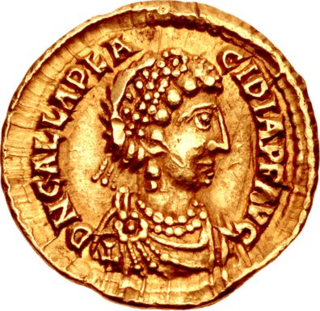
Galla Placidia, daughter of the Roman emperor Theodosius I, was a mother, tutor, and advisor to emperor Valentinian III. She was queen consort to Ataulf, king of the Visigoths from 414 until his death in 415, briefly empress consort to Constantius III in 421, and managed the government administration as a regent during the early reign of Valentinian III until her death.
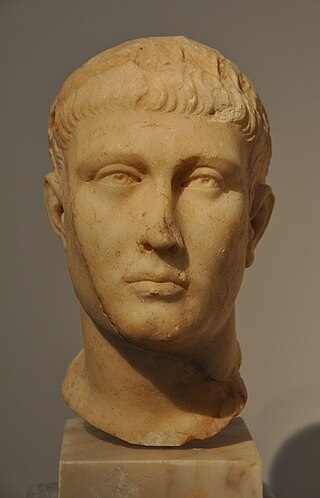
Theodosius I, also known as Theodosius the Great, was a Roman emperor from 379 to 395. He won two civil wars, and was instrumental in establishing the Nicene Creed as the orthodox doctrine for Nicene Christianity. Theodosius was the last emperor to rule the entire Roman Empire before its administration was permanently split between the Western Roman Empire and the Eastern Roman Empire. He successfully ended the Gothic War (376–382) with terms advantageous to the empire, with the Goths remaining in Roman territory but as subject allies.
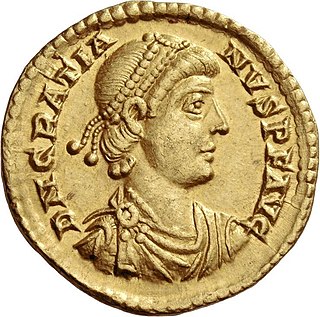
Year 383 (CCCLXXXIII) was a common year starting on Sunday of the Julian calendar. At the time, it was known as the Year of the Consulship of Merobaudes and Saturninus. The denomination 383 for this year has been used since the early medieval period, when the Anno Domini calendar era became the prevalent method in Europe for naming years.
Fritigern was a Thervingian Gothic chieftain whose decisive victory at Adrianople during the Gothic War (376–382) led to favourable terms for the Goths when peace was made with Gratian and Theodosius I in 382.

Magnus Maximus was Roman emperor in the West from 383 to 388. He usurped the throne from emperor Gratian.

Gratian was emperor of the Western Roman Empire from 367 to 383. The eldest son of Valentinian I, Gratian was raised to the rank of Augustus as a child and inherited the West after his father's death in 375. He nominally shared the government with his infant half-brother Valentinian II, who was also acclaimed emperor in Pannonia on Valentinian's death. The East was ruled by his uncle Valens, who was later succeeded by Theodosius I.
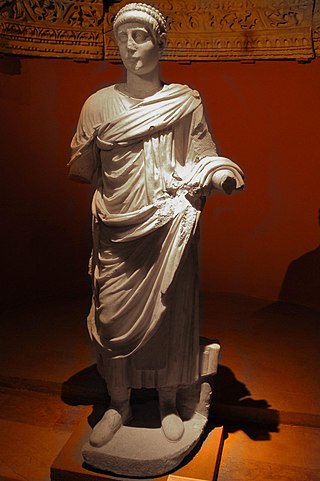
Valentinian II was a Roman emperor in the western part of the Roman empire between AD 375 and 392. He was at first junior co-ruler of his half-brother, then was sidelined by a usurper, and finally became sole ruler after 388, albeit with limited de facto powers.
Salamanes Hermias Sozomenos, also known as Sozomen, was a Roman lawyer and historian of the Christian Church.

The end of Roman rule in Britain occurred as the military forces of Roman Britain withdrew to defend or seize the Western Roman Empire's continental core, leaving behind an autonomous post-Roman Britain. In 383, the usurper Magnus Maximus withdrew troops from northern and western Britain, probably leaving local warlords in charge. In 407, usurper Constantine III took the remaining mobile Roman soldiers to Gaul in response to the crossing of the Rhine, and external attacks surged. The Romano-British deposed Roman officials around 410 and government largely reverted to the city level. That year Emperor Honorius refused an appeal from Britain for military assistance. The following decades saw the collapse of urban life and the beginning of Anglo-Saxon settlement.

Victor was a Western Roman emperor from either 383/384 or 387 to August 388. He was the son of the magister militum Magnus Maximus, who later became a usurper of the Western Roman Empire, in opposition to Gratian. Maximus rose up in 383, and was recognized as the legitimate emperor in the west by Theodosius I. Victor was elevated to augustus of the Western Roman Empire in either 383/384 or mid-387, making him co-emperor with his father. Maximus invaded Italy in 387, to depose Valentinian II, the brother and successor of the late Gratian. Because of Maximus' invasion, Theodosius invaded the Western Empire in 388. Theodosius defeated Maximus in two battles in Pannonia, before crushing his army at Aquilea, and capturing Maximus. Maximus was executed on 28 August 388. His death was followed quickly by that of Victor, who was executed in Trier by the Frankish general Arbogast.

The Theodosian dynasty was a Roman imperial family that produced five Roman emperors during Late Antiquity, reigning over the Roman Empire from 379 to 457. The dynasty's patriarch was Theodosius the Elder, whose son Theodosius the Great was made Roman emperor in 379. Theodosius's two sons both became emperors, while his daughter married Constantius III, producing a daughter that became an empress and a son also became emperor. The dynasty of Theodosius married into, and reigned concurrently with, the ruling Valentinianic dynasty, and was succeeded by the Leonid dynasty with the accession of Leo the Great.

The Valentinian dynasty was a ruling house of five generations of dynasts, including five Roman emperors during late antiquity, lasting nearly a hundred years from the mid fourth to the mid fifth century. They succeeded the Constantinian dynasty and reigned over the Roman Empire from 364 to 392 and from 425 to 455, with an interregnum (392–423), during which the Theodosian dynasty ruled and eventually succeeded them. The Theodosians, who intermarried into the Valentinian house, ruled concurrently in the east after 379.
Justina was a Roman empress. She was initially the wife of the rebel emperor Magnentius and was then married to Valentinian I, with whom she had four children, including the emperor Valentinian II and the empress Galla.
Arbogast or Arbogastes was a Roman army officer of Frankish origin. He won distinction in the service of the emperor Gratian, and was subsequently entrusted by Theodosius I with the guardianship of the underage Valentinian II. The death of Valentinian in mysterious circumstances, and the rise of the controversial Eugenius, led to a civil war in which Arbogast perished.
Galla was a Roman empress as the second wife of Theodosius I. She was the daughter of Valentinian I and his second wife Justina.

The Massacre of Thessalonica in Macedonia, Greece, was a massacre of local civilians by Roman troops which is believed to have occurred around 390. According to Sozomen, in June of that year Butheric, a Roman general stationed in Thessalonica as a magister militum was lynched in an urban riot by an angry mob in the circus after having a famous circus charioteer arrested for pederasty, and refusing the people's demand for his release, although, this is found in only one source. In response, Theodosius authorized his Gothic soldiers to punish the people of the city resulting in the killing of a large number of citizens when they were assembled in the city's hippodrome.

Constantia (362–383) was the first empress consort of Gratian of the Western Roman Empire. According to Ammianus Marcellinus, her mother was Faustina and her father was Constantius II, who died before Constantia was born.
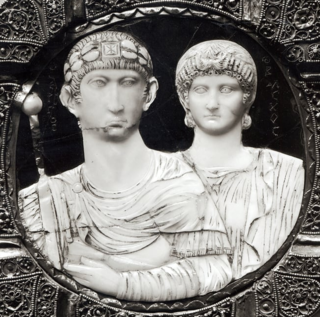
Maria was the first Empress consort of Honorius, Western Roman Emperor. She was the daughter of the general Stilicho. Around 398 she married her first cousin, the Emperor Honorius. It is uncertain when she was born, but she was probably no older than fourteen at the time of her marriage. Maria had no children, and died in 407. After her death, Honorius married her sister, Thermantia.
Flavius Merobaudes was a Roman army officer of Frankish origin. He was appointed magister peditum around 375, and consul twice in 377 and 383. Ancient sources record that he was put to death that year for his support of the imperial usurper Magnus Maximus, but an inscription records that he became consul a third time in 388.

Athanaric or Atanaric was king of several branches of the Thervingian Goths for at least two decades in the 4th century. Throughout his reign, Athanaric was faced with invasions by the Roman Empire, the Huns and a civil war with Christian rebels. He is considered the first king of the Visigoths, who later settled in Iberia, where they founded the Visigothic Kingdom.